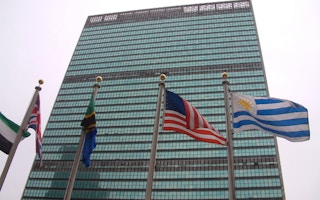If the Sustainable Development Goals (SDGs) are to be achieved, then policymakers need to focus less on individual targets and more on the links between the 17 Goals to create a cleaner, greener, fairer world by 2030, experts said at the annual High-Level Political Forum (HLPF) event held at the United Nations (UN) in New York last week.
Chief executive of Washington-based non-profit Millennium Institute, John Hardy, who attended the forum, told Eco-Business that a more cross-sectoral, interconnected approach to national policy could accelerate progress on the SDGs.
“There isn’t any overall awareness that all these goals are interlinked and that there are cross impacts, whether positive or negative,” he said.
Most countries manage areas of public policy such as energy, education, agriculture and health through separate agencies. While this allows for greater accountability and specialisation, the lack of joint coordination between sectors often results in inefficient policy actions, according to a paper titled Understanding and Mapping Important Interactions among SDGs that was published in the lead-up to last year’s forum.
The paper also stated that development and environmental goals cannot be reached in isolation from other goals, referring to the SDG agenda as an “indivisible whole.”
“
There isn’t any overall awareness that all these goals are interlinked and that there are cross impacts, whether positive or negative.
John Hardy, chief executive, Millennium Institute
The 2030 SDG agenda comprises of 17 global goals spanning different areas of environmental, economic, social and cultural development, with each goal branching out into a separate list of indicators and targets.
At the launch of this year’s HLPF, the UN Sustainable Development Solutions Network released a report that found that no country in the world is currently on track to achieving their goals by 2030.
“I think it is very clear that the achievements of the SDGs will be fundamentally dependent on people having a more objective assessment on how the whole concept holds together in any given country situation,” said Hardy.
He added that while discussions at the HLPF did touch on the synergies between the SDGs, there was a gap in solutions that would enable countries to evaluate those linkages and help them incorporate the Goals into their national planning processes.
A tool to advance the SDG agenda
One mechanism that has been used by countries to understand the interactions between the SDGs and test the coherence of various policies before they are adopted is the Integrated Sustainable Development Goal Model (iSDG). Developed by the Millennium Institute and based on their original Threshold 21 (T21) technology, iSDG is a visual simulation tool that allows users to test all desired policy interventions simultaneously to assess their impacts on the various SDGs. The tool is designed to help policymakers get a better idea of where investment should be made to attain the SDGs.
“Experiments over the years have shown that human beings simply don’t make good decisions in complex systems,” said Steven Arquitt, a technical modeller at Millennium Institute. “We have cognitive limitations when it comes to intuiting feedback, information delays, and time lags.”
The iSDG model helps countries manage the complexity of the SDGs by accounting for these deficits, and calculates how different combinations of policies will impact progress towards the agenda in the real world.
The T21 technology is not new to policymakers, having been used by over 40 countries, including the governments of Senegal, Swaziland, Peru, Venezuela, China and the Philippines. The updated iSDG model is custom-made for countries through consultations with local and national stakeholders, placing each country’s needs and priorities in a unique development context.
The iSDG also has a strong emphasis on training local players and fostering country ownership of their policy projects, relying on international as well as locally-sourced data as they develop in-country teams to run the model.
“We very much rely on the contribution of local expertise from national governments,” said Hardy. “Local teams become effectively trained in the subject matter according to the priorities of the country, and are trained in model development so they can continue to enhance its value over time.”
Presenting the country’s Voluntary National Review (VNR) at the HLPF ministerial meeting this year, Senegal used the iSDG model to track its progress and foresee necessary steps to achieving its targets by 2030. The VNRs are country-led reviews by UN member states that aim to facilitate the sharing of challenges and successes in implementing the SDGs.
According to iSDG’s projections, Senegal’s national plan from 2014 to 2018 had worked to attain closer achievement of the SDGs with a 49 per cent level of achievement by 2030, compared to a 27 per cent level of achievement if public policy over the years had remained unchanged.
“The [five-year plan] scenario [via the iSDG] gives a better perspective for Senegal by 2030. In fact, a clear improvement in all levels of the SDGs is observed,” said Mahi Amadou Deme, division chief at the Ministry of Economy, Finance and Planning of Senegal. He added that the high rate of economic growth is predicted to significantly impact areas such as food security and health, while allowing the country to better handle environmental issues related to forests and soil.
While the iSDG model has been employed by an array of governments, it has yet to be used by business. Side events at the HLPF generated discussion on the role of the private sector in accelerating progress on the SDGs and how business decisions have a direct impact on specific development goals and targets.
“There is growing awareness in the international business community of the SDGs and that some businesses are recognising them in their corporate plans,” said Arquitt, “The question is: will this lead to actions that really move the world towards SDG achievement, or does this just amount to greenwashing?”
Arquitt proposed that business planners use the iSDG, customised to their respective business, to understand the interwoven nature of the SDGs and monitor the impact of corporate strategies aligned to the 2030 agenda.

















